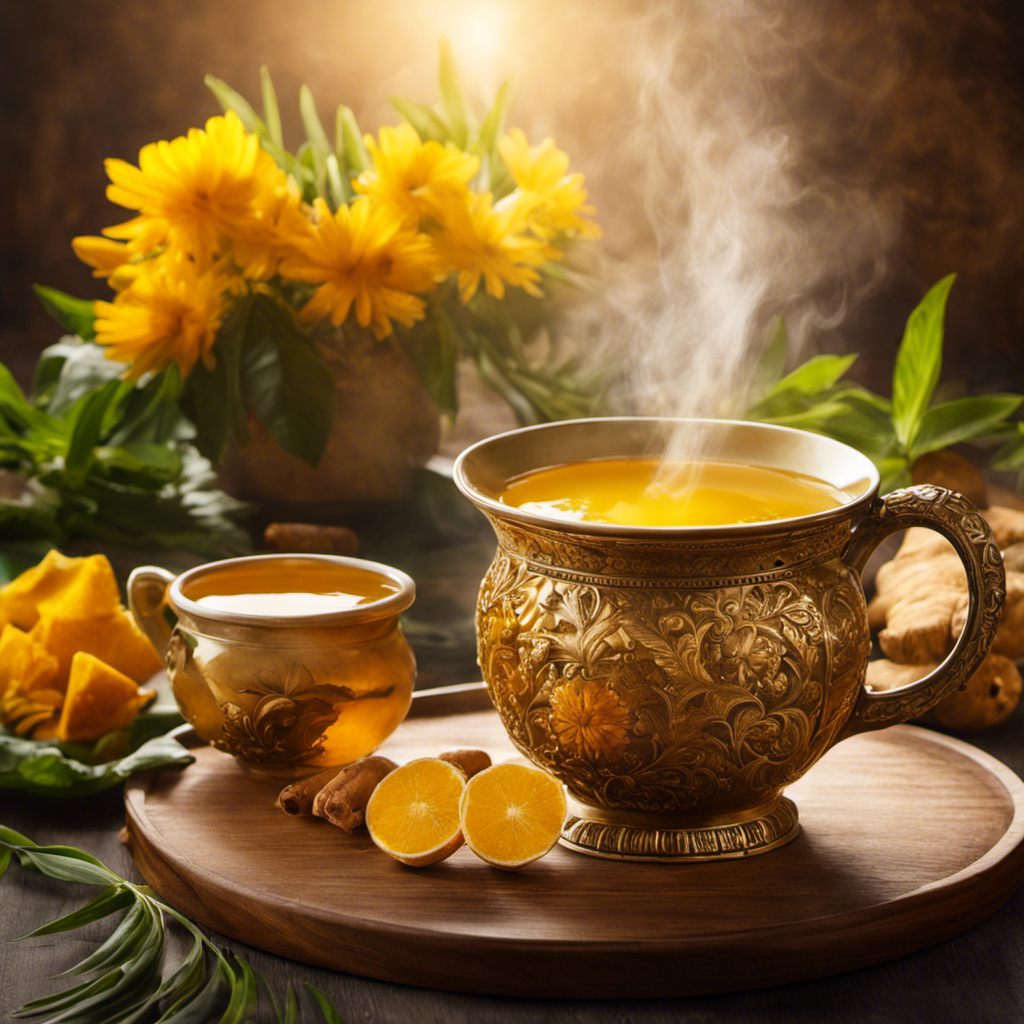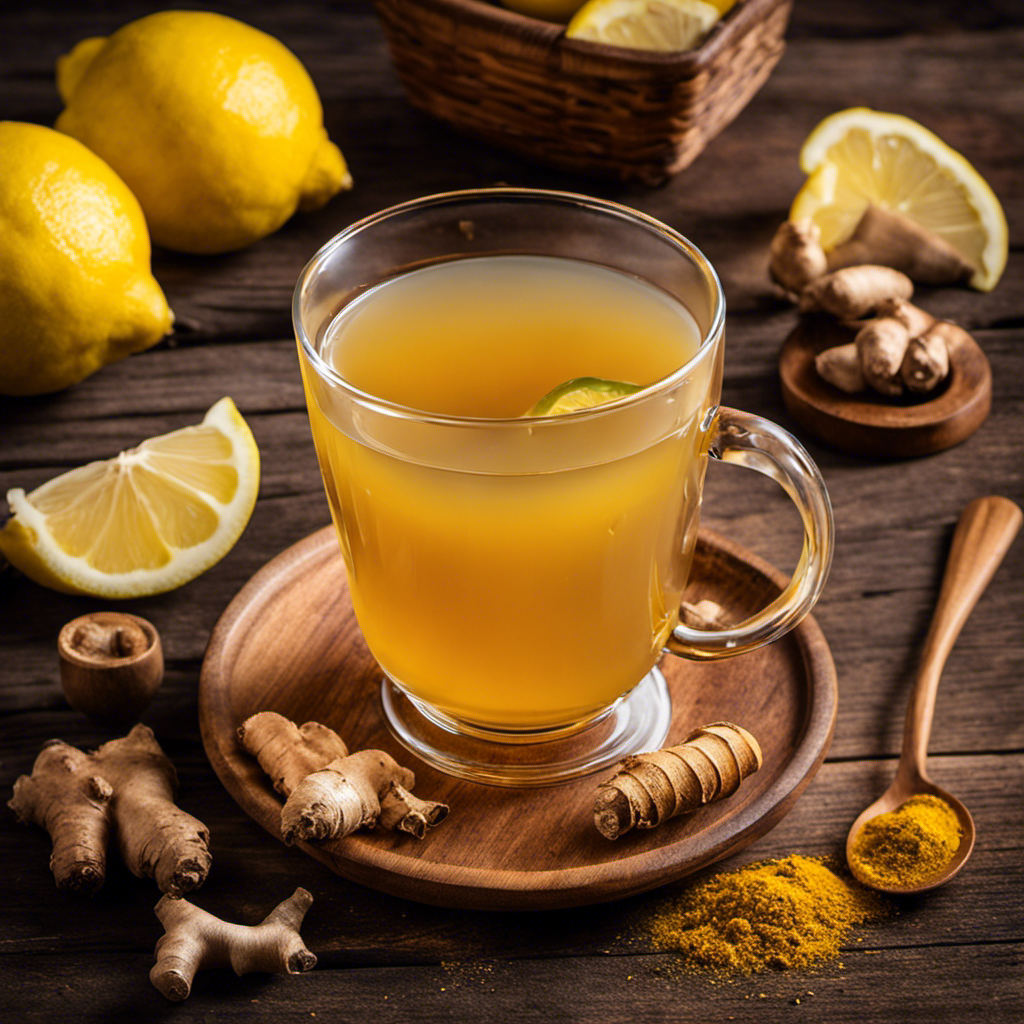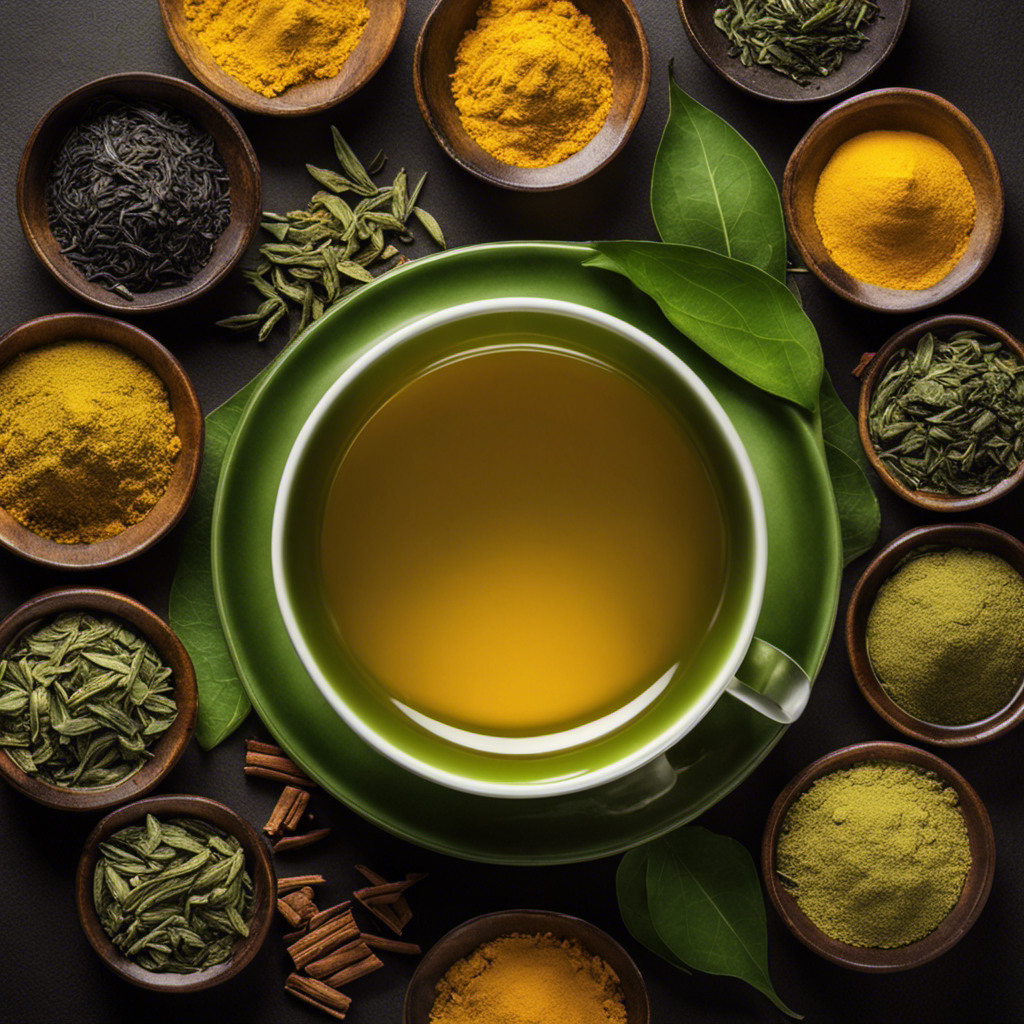Matcha
What Tops the Antioxidant Chart: Coffee or Green Tea?

When it comes to the battle of antioxidants, the question of whether coffee or green tea reigns supreme has sparked much debate.
In this article, we delve into the depths of this antioxidant chart showdown to uncover the ultimate winner. Prepare to discover the secrets behind the antioxidant powerhouses of coffee and green tea.
We will examine the nutritional breakdown, unveiling the hidden treasures each beverage holds. By the end, you’ll have a comprehensive understanding of the health benefits that these two beverages offer.
So, join us on this journey of exploration as we determine what truly tops the antioxidant chart: coffee or green tea. Let the battle begin!
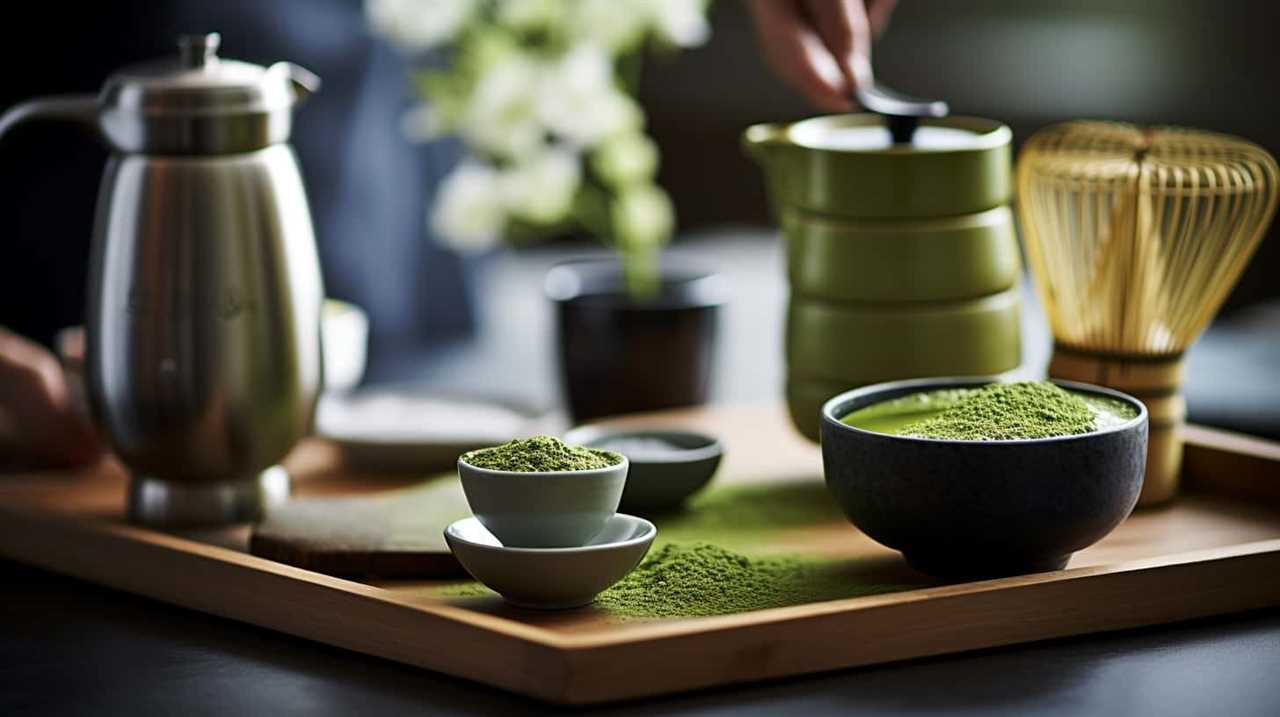
Key Takeaways
- Matcha contains a high concentration of antioxidants, particularly catechins.
- Coffee contains antioxidants, primarily chlorogenic acid.
- Both matcha and coffee offer unique antioxidant compounds.
- Matcha’s antioxidants may help protect against oxidative stress and damage, promote relaxation, aid in weight loss, and potentially prevent heart disease and certain types of cancer. Coffee’s antioxidants may help reduce inflammation, aid in weight loss, improve physical performance, increase alertness, and potentially reduce the risk of heart disease and type 2 diabetes.
Matcha Vs. Coffee: Antioxidant Showdown
In this article, we’ll compare the antioxidant levels of matcha and coffee, determining which one comes out on top.
Matcha, a type of powdered green tea, has gained popularity in recent years due to its numerous health benefits. One of the key advantages of matcha is its high concentration of antioxidants. Antioxidants are compounds that help protect our bodies against damage caused by free radicals. Matcha contains a specific type of antioxidant called catechins, which are known for their potent health-promoting properties.
Coffee, on the other hand, also contains antioxidants, but in different forms. The most abundant antioxidant in coffee is chlorogenic acid. While both matcha and coffee provide antioxidant benefits, the specific types and concentrations differ.
In the next section, we’ll delve deeper into the antioxidant content of matcha and coffee to determine which one reigns supreme in terms of health benefits.
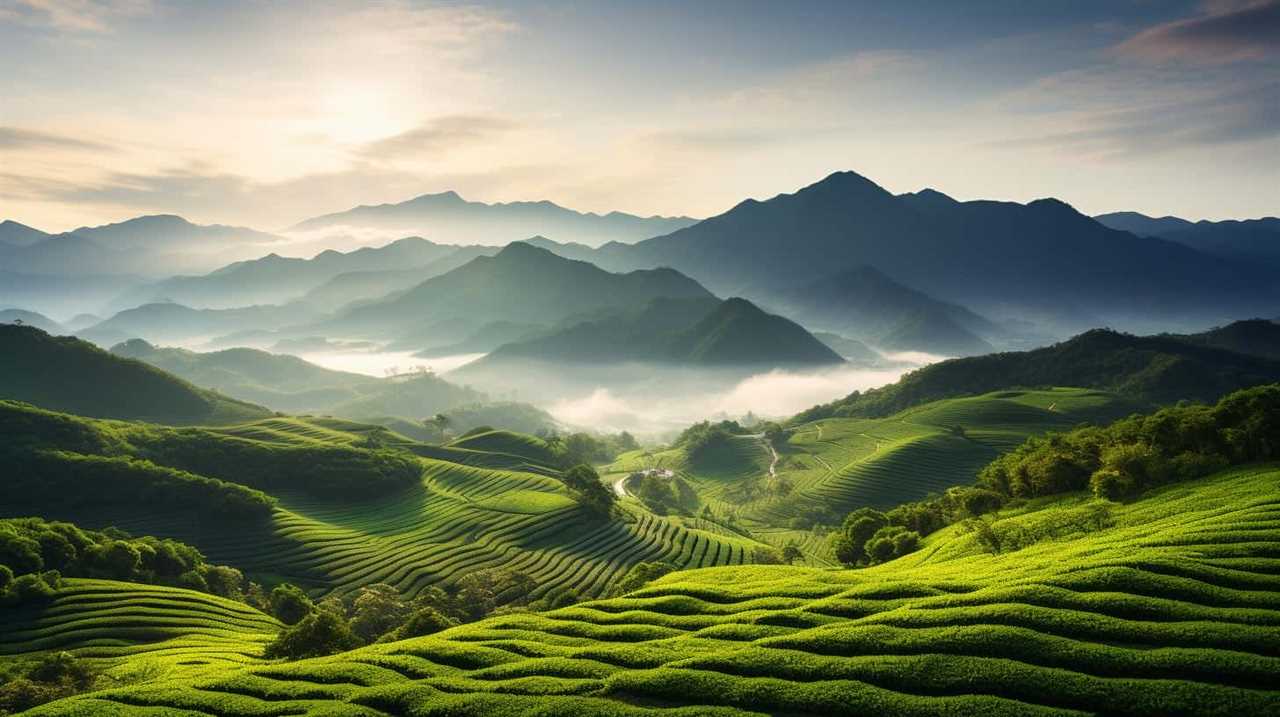
Understanding Matcha’s Antioxidant Power
Continuing our exploration of the antioxidant levels in matcha and coffee, let’s delve into the impressive antioxidant power of matcha.
Matcha is known for its high concentration of antioxidants, which are beneficial compounds that help protect our bodies against oxidative stress and damage caused by harmful molecules called free radicals.
Here are three key factors that contribute to matcha’s antioxidant potency:
- Understanding matcha’s cultivation process: Matcha is made from shade-grown tea leaves that are carefully picked, steamed, and stone-ground into a fine powder. This unique cultivation process helps to preserve the levels of antioxidants, such as catechins, in the tea leaves.
- Exploring the different grades of matcha: Matcha comes in different grades, with ceremonial grade being the highest quality. Ceremonial grade matcha is made from the youngest leaves and has the highest antioxidant content compared to lower grades.
- Retaining the whole leaf: Unlike other teas, matcha is consumed by whisking the powdered leaves into water, allowing us to consume the whole leaf and benefit from all its antioxidant goodness.
Now, let’s transition to the subsequent section where we reveal the antioxidant content found in coffee.
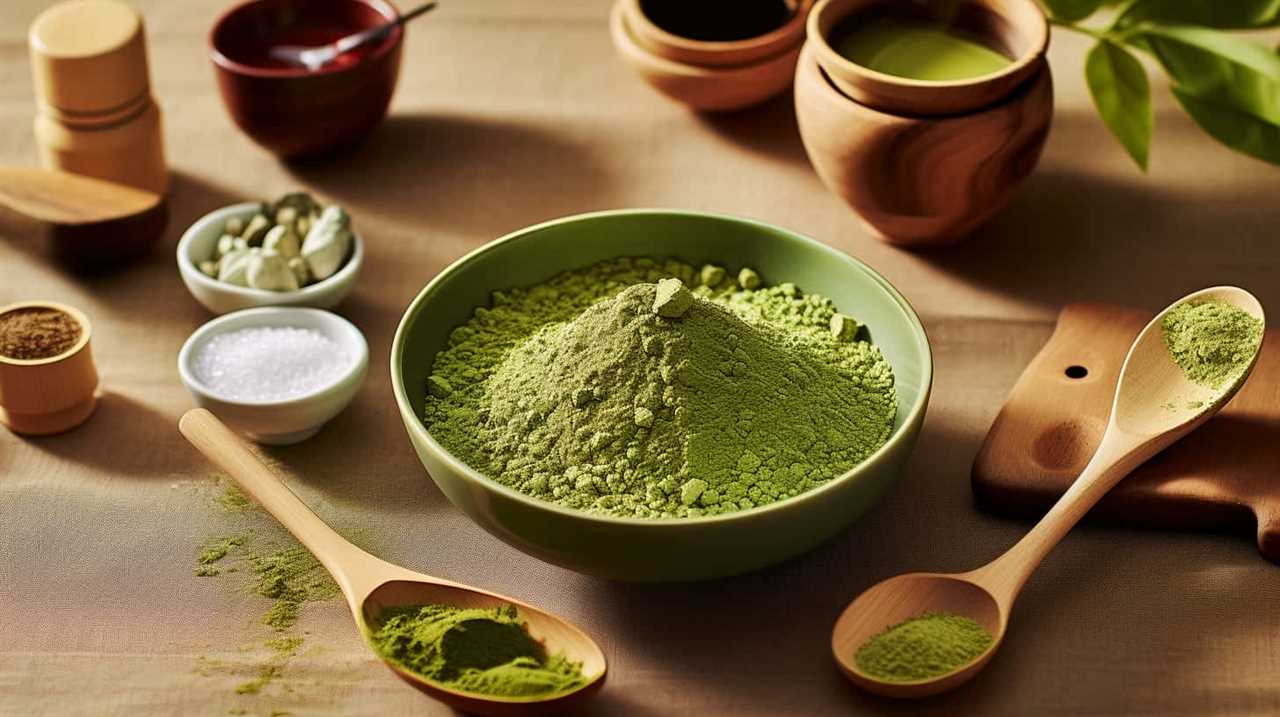
Coffee’s Antioxidant Content Revealed
Now, let’s uncover the impressive antioxidant content found in coffee. Numerous studies have been conducted to explore coffee’s antioxidant properties and their potential health benefits. Coffee is rich in various antioxidants, including phenolic compounds, flavonoids, and chlorogenic acids. These antioxidants have been found to have a range of beneficial effects on human health, such as reducing inflammation, protecting against oxidative stress, and potentially lowering the risk of chronic diseases like heart disease and certain types of cancer.
Here is a table summarizing some of the key antioxidants found in coffee:
| Antioxidant | Benefits |
|---|---|
| Caffeic Acid | May have anti-inflammatory properties |
| Quinic Acid | May have antimicrobial effects |
| Ferulic Acid | May help protect against UV damage |
| Chlorogenic Acid | May help regulate blood sugar levels |
| Cafestol and Kahweol | May have anti-cancer properties |
While green tea is often lauded for its antioxidant content, it is important to recognize that coffee also provides a significant source of antioxidants that contribute to its potential health benefits.
Comparing Matcha and Coffee: Nutritional Breakdown
Moving forward from exploring coffee’s antioxidant content, let’s now delve into a nutritional breakdown comparing matcha and coffee.

When it comes to caffeine content, matcha and coffee differ significantly. While coffee is known for its high caffeine levels, matcha contains about half the amount of caffeine per serving. This makes matcha a suitable option for those who are sensitive to caffeine or prefer a milder energy boost.
Additionally, the brewing methods used to prepare matcha and coffee can impact their nutritional value. Matcha is made by grinding whole tea leaves into a fine powder, allowing you to consume the entire leaf and maximize its nutritional benefits. On the other hand, coffee is brewed, which may result in the loss of certain antioxidants during the process.
Now, let’s explore the health benefits of matcha and coffee.
The Health Benefits of Matcha and Coffee
While both matcha and coffee offer various health benefits, it is important to compare their specific advantages and consider which one tops the antioxidant chart. Matcha, a powdered form of green tea, is known for its high concentration of antioxidants and numerous health benefits. It contains a type of antioxidant called catechins, which have been shown to have anti-inflammatory and anti-cancer properties. Matcha also contains L-theanine, an amino acid that promotes relaxation and mental clarity. On the other hand, coffee is rich in antioxidants, such as chlorogenic acid, which has been associated with a reduced risk of chronic diseases like heart disease and type 2 diabetes. Coffee also contains caffeine, which can increase alertness and improve physical performance. Both matcha and coffee have been linked to potential weight loss benefits, as they can boost metabolism and increase fat oxidation. However, it is important to note that individual responses to these beverages may vary.
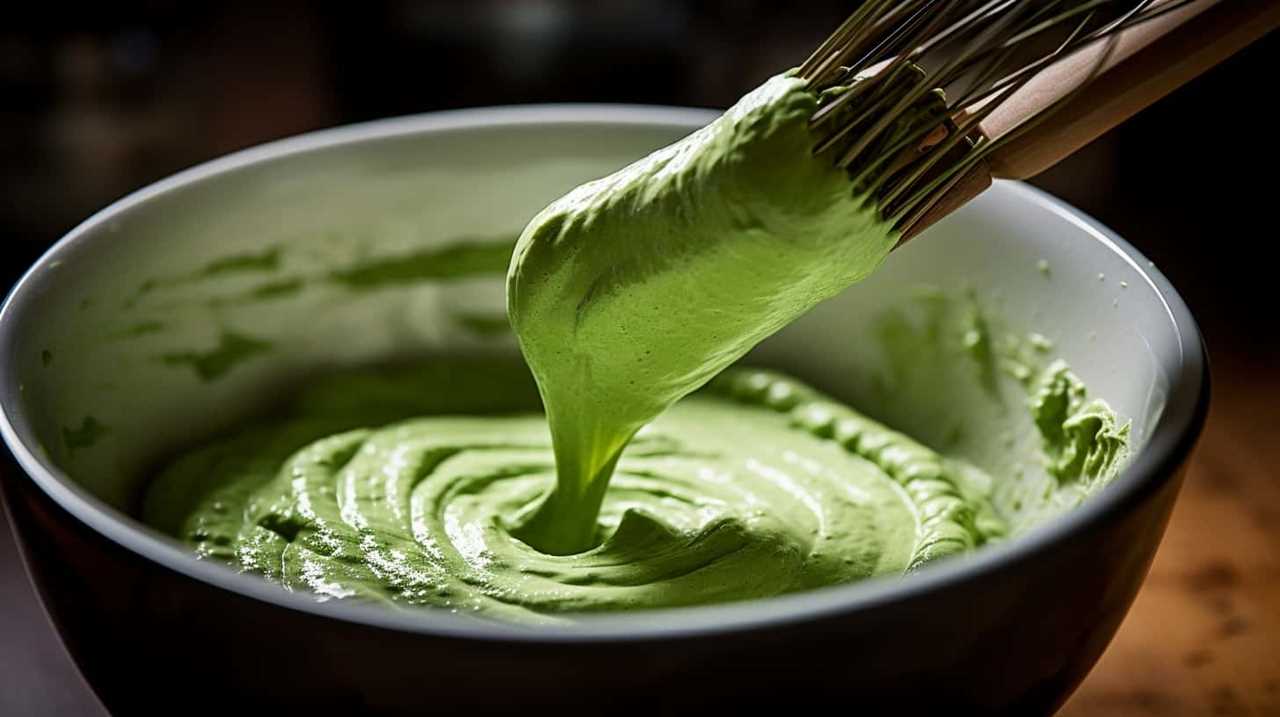
| Health Benefits | Matcha | Coffee |
|---|---|---|
| Antioxidant content | High | High |
| Promotes relaxation | Yes | No |
| Potential weight loss benefits | Yes | Yes |
Frequently Asked Questions
How Does the Oxidation Process Affect the Antioxidant Content in Coffee and Green Tea?
The oxidation process impacts the antioxidant content in coffee and green tea, altering their levels. It is important to understand how this process affects these beverages to determine which one tops the antioxidant chart.
Can Drinking Coffee or Green Tea Help Prevent Chronic Diseases Such as Cancer and Heart Disease?
Drinking coffee or green tea may help prevent chronic diseases like cancer and heart disease. Both beverages contain antioxidants that can protect against oxidative damage. However, further research is needed to determine which one tops the antioxidant chart.
Are There Any Potential Side Effects or Risks Associated With Consuming High Amounts of Coffee or Green Tea?
In considering the potential risks of excessive coffee or green tea consumption, it is important to examine the long-term effects of high caffeine intake. These effects can vary depending on individual sensitivity and overall health.
How Does the Preparation Method (E.G., Brewing or Steeping) Affect the Antioxidant Levels in Coffee and Green Tea?
The effect of temperature and brewing time on antioxidant levels in coffee and green tea, as well as the impact of different brewing methods on antioxidant content, are important factors to consider when comparing the two beverages.

Are There Any Other Factors Besides Antioxidants That Contribute to the Health Benefits of Coffee and Green Tea?
Well, besides antioxidants, there are other factors that contribute to the health benefits of coffee and green tea. Caffeine provides a boost of energy, while polyphenols have been linked to various health benefits.
Conclusion
In the battle of antioxidants, matcha and coffee both bring their unique benefits to the table.
Matcha, with its vibrant green color and smooth taste, packs a powerful punch of antioxidants, promoting overall health and well-being.
Coffee, on the other hand, offers a rich and bold flavor while also providing antioxidant protection.

Whether you choose matcha or coffee, incorporating these beverages into your daily routine can be a delicious way to support your body’s antioxidant needs.
Justin is a seasoned author, coffee and tea enthusiast, and an essential member of the Cappuccino Oracle team. With a keen appreciation for the complexities of coffee, coffee alternatives, and tea, Justin has dedicated his professional career to exploring these realms and sharing his insights with readers worldwide.
Justin’s immersion in the world of coffee, coffee alternatives, and tea began at a young age, kindling a passion that extended beyond mere consumption. This love for these beverages led him to combine his talent for writing with his devotion to coffee and tea, bringing him to Cappuccino Oracle as a dedicated author.
Matcha
Unveiling The Mysteries Of Matcha: Insights On Its Origins, Production, And Quality

Have you ever been curious about the mysteries behind the rich and natural flavors of matcha? If so, get ready to join me on an adventure as we uncover the secrets of matcha, delving into its origins, production, and quality.
As a lover of all things tea, I have delved deep into the world of matcha, immersing myself in its rich history and intricate production process. From the shade-grown tea leaves to the meticulous grinding technique, every step is a labor of love that culminates in the velvety smooth powder we know as matcha.
Join me as we unravel the secrets behind this ancient Japanese tradition and discover why quality is key when indulging in this verdant elixir. We’ll explore the nuances of flavor, the importance of sourcing, and even delve into the fascinating world of other tea varieties.
So grab a cup, sit back, and let’s dive into the captivating world of matcha.
Key Takeaways
- Matcha tea is made from powdered green tea leaves and has a long and labor-intensive production process.
- Premium matcha is made from the first harvest in early spring, using the top 3 sprouts of the tea plant and ground tencha leaves.
- Cheaper matchas may skip some steps in the production process and are more suitable for matcha lattes.
- High-quality matcha is recommended for sparing consumption, as it has a smoother flavor and more health benefits compared to cheaper matchas.
What is matcha?
I’ve learned that matcha is a powdered green tea made from special tea leaves that are shaded before harvest, and it has a long and labor-intensive production process.
There are different types of matcha available, but the premium matcha is made from the first harvest in early spring, using only the top 3 sprouts of the tea plant. The leaves are then steamed, dried, and have their stems removed before being ground into a fine powder using a specialized mill made of granite.
It’s important to note that high-quality matcha is recommended for sparing consumption, as it has a complex production process that results in a smooth flavor. Matcha also offers various health benefits, such as being rich in antioxidants, boosting metabolism, and improving mental alertness.
Production process
The matcha production process involves shading the tea leaves before harvest and selecting the top three sprouts of the tea plant for premium matcha. Shading is a technique used to enhance the flavor and quality of the tea leaves. By covering the tea plants with shade, the leaves produce more chlorophyll and amino acids, resulting in a vibrant green color and a rich, umami taste.
After the shading period, only the top three sprouts of the tea plant are carefully handpicked for premium matcha. These selected leaves, known as tencha leaves, are then steamed, dried, and have their stems removed.
Finally, the tencha leaves are ground into a fine powder using a specialized granite mill. This process results in the smooth and concentrated matcha powder that we enjoy.
Quality and consumption
Let me tell you, indulging in high-quality matcha is like sipping a vibrant green elixir that awakens your taste buds and nourishes your body with its rich flavor and numerous health benefits. Matcha’s health benefits are truly remarkable. Packed with antioxidants, vitamins, and minerals, matcha is known to boost metabolism, enhance focus and concentration, and strengthen the immune system.
But not all matcha is created equal. Different grades of matcha exist, ranging from ceremonial grade to culinary grade. Ceremonial grade matcha is made from the highest quality tencha leaves and has a smooth, vibrant green color and a delicate, umami flavor. It is best enjoyed on its own, whisked with hot water.
On the other hand, culinary grade matcha is more affordable and is suitable for making matcha lattes, smoothies, and baked goods. Although it may have a slightly bitter taste and a duller color, it still provides health benefits.
So, whether you choose to indulge in high-quality ceremonial grade matcha or opt for the more affordable culinary grade, incorporating matcha into your routine is a delicious way to reap its health benefits.
Frequently Asked Questions
What are some popular ways to enjoy matcha besides drinking it as tea?
Besides drinking matcha as tea, some popular ways to enjoy it include indulging in matcha desserts like matcha ice cream, matcha cake, and matcha cookies. Additionally, matcha smoothies are a refreshing and healthy option.
Are there any specific health benefits associated with consuming matcha?
I’m no expert, but matcha is said to have potential health benefits. Some claim it can aid in weight loss due to its high antioxidant content and metabolism-boosting properties. However, more research is needed to confirm these claims.
How does the quality of matcha affect its flavor and overall experience?
The quality of matcha directly affects its flavor and overall experience. Higher quality matcha, made from carefully selected leaves and processed with precision, offers a smoother and more vibrant flavor, while lower quality matcha may have a less appealing taste and color.
Can matcha be used in cooking or baking?
"Where there’s matcha, there’s a way! Matcha can be used in a variety of cooking and baking recipes, adding a vibrant green color and a unique earthy flavor to dishes like matcha desserts."
Are there any specific tips or techniques for properly preparing matcha tea at home?
To properly prepare matcha tea at home, start by sifting the matcha powder to remove any clumps. Then, choose water at around 175°F to 180°F for the best flavor. Gradually add water to the matcha and whisk in a "W" or "M" motion until frothy. Enjoy!
Conclusion
In conclusion, matcha tea is not just a beverage, but a rich and fascinating tradition that has evolved over centuries.
From its origins in Japan to its intricate production process, matcha is a labor of love.
The quality of matcha is crucial, as the steps taken in its production directly impact its flavor and aroma.
Whether you’re a matcha connoisseur or a beginner, there is a matcha tea out there for you.
So, why not indulge in a cup of this vibrant green elixir and experience the magic of matcha for yourself? It’s a journey worth embarking on!
Arf, an author and an innovative enthusiast of coffee, coffee alternatives, and tea, plays a crucial role as a contributor to the esteemed Cappuccino Oracle platform. Renowned for his curiosity and passion for these captivating beverages, Arf has carved out a unique space for himself in the world of exploration and writing. He realized that coffee, coffee alternatives, and tea are not mere drinks to keep one awake, but universes of flavors and stories waiting to be explored.
Arf’s articles for Cappuccino Oracle blend meticulous research with personal experiences, providing readers with an in-depth understanding of various types of coffee, coffee alternatives, and tea, along with their unique characteristics, cultures, and histories. His honest reviews and engaging narratives guide readers on their own journeys, helping them discover their preferences and find their perfect brew.
Matcha
Unveiling The Truth Behind Starbucks’ Matcha: A Disappointing Blend

Being a lover of tea, I was eager to sample Starbucks’ matcha beverages, anticipating a flavorful and genuine taste. However, to my dismay, I found that it was a subpar mixture of inexpensive green tea powder and an excessive amount of sugar. This was a stark contrast to the customary matcha experience that I had grown accustomed to.
The use of low-quality matcha by Starbucks is driven by the need for mass production and a consistent taste across all locations. But in this pursuit, they have sacrificed the true essence of matcha. Authentic matcha production involves meticulous steps to ensure a high-quality and flavorful product, steps that Starbucks seems to skip.
The result is a matcha latte packed with 32 grams of sugar, equivalent to a can of soda, and a whopping 240 calories. It’s time to unveil the truth behind Starbucks’ matcha and explore better options for a truly satisfying tea experience.
Key Takeaways
- Starbucks uses a cheap green tea powder for their matcha drinks, which may not even be considered matcha.
- The cheap matcha powder is mixed with a lot of sugar, negating the health benefits and undermining the quality of the tea.
- Starbucks’ matcha latte contains a high amount of sugar, similar to a can of soda, and has a significant number of calories.
- To have a better matcha experience, it is recommended to explore premium, first harvest matcha made by talented farmers in Japan and to try different matcha options to find preferred taste.
What is Starbucks Matcha?
Starbucks Matcha is a cheap green tea powder mixed with a high amount of sugar, which not only undermines the health benefits of matcha but also fails to deliver the natural, great-tasting flavor of authentic matcha tea.
The ingredients used in Starbucks matcha include low-quality green tea powder that is likely produced on a large scale. Unlike traditional matcha production methods, Starbucks skips certain steps to save time and money. These steps, such as shading the tea plants to reduce bitterness and selecting the top leaves for their flavor and nutrients, are crucial in creating high-quality matcha.
Instead, Starbucks opts for a blend of cheap green tea powder mixed with sugar, resulting in a dull and bitter flavor. This disappointing blend of ingredients does not live up to the standards of true matcha tea.
Quality vs. Cheap Matcha
Indulging in high-quality matcha is like savoring a delicate melody that dances on your taste buds, while settling for cheap matcha is akin to a discordant symphony that leaves a bitter aftertaste. When it comes to matcha, quality matters. Traditional matcha production is an art that requires time, patience, and attention to detail. The importance of shading the tea plants, selecting the top leaves, and using a stone mill to grind the leaves into a fine powder cannot be overstated. These steps not only enhance the flavor but also preserve the health benefits of matcha. High-quality matcha is rich in antioxidants, boosts metabolism, and promotes a sense of calm. On the other hand, cheap matcha often lacks these qualities as it skips crucial steps and is mixed with sugar and other additives. Don’t settle for a subpar matcha experience; choose high-quality matcha for its exceptional taste and health benefits.
| Traditional Matcha Production |
|---|
| Shading the tea plants |
| Selecting the top leaves |
| Grinding with a stone mill |
The importance of traditional matcha production cannot be overstated. These steps not only enhance the flavor but also preserve the health benefits of matcha. High-quality matcha is rich in antioxidants, boosts metabolism, and promotes a sense of calm. On the other hand, cheap matcha often lacks these qualities as it skips crucial steps and is mixed with sugar and other additives. Don’t settle for a subpar matcha experience; choose high-quality matcha for its exceptional taste and health benefits.
Recommendations for Better Matcha
Exploring different matcha options can lead to a better matcha experience. When it comes to matcha, not all options are created equal. While Starbucks may offer a convenient matcha latte, there are alternative options that provide a more authentic and higher quality experience.
Premium matcha, specifically first harvest matcha, is made by talented farmers in Japan and can be enjoyed plain, without the need for excessive sugar or additives. By choosing premium matcha, you can reap the full benefits that matcha has to offer, such as its high antioxidant content and potential health benefits.
Additionally, exploring different types of matcha, such as Japanese black tea, can expand your taste palate and introduce you to new and exciting flavors. So, why settle for a disappointing blend when there are better matcha options out there waiting to be explored?
Frequently Asked Questions
How is Starbucks matcha different from traditional matcha?
Starbucks matcha differs from traditional matcha in terms of quality and taste. One interesting statistic is that Starbucks’ matcha latte contains 32 grams of sugar, similar to a can of soda, which undermines the health benefits of matcha.
What are the health benefits of matcha and how do they differ between Starbucks matcha and premium matcha?
The health benefits of matcha include high levels of antioxidants, increased energy, and improved focus. However, Starbucks matcha quality is compromised due to the use of cheap powder mixed with sugar, negating these benefits.
Can you customize the sweetness level of Starbucks matcha drinks?
Yes, you can customize the sweetness level of Starbucks matcha drinks. They offer popular matcha drink variations like matcha latte and matcha frappuccino, allowing customers to choose the amount of sweetener they prefer.
Are there any alternative options for matcha drinks at Starbucks?
Yes, there are alternative options for matcha drinks at Starbucks. However, it’s important to note that the taste may not be comparable to traditional matcha. Exploring different matcha options and Japanese black tea can provide a better experience.
What are the steps involved in producing high-quality matcha and how does Starbucks’ matcha production differ?
Starbucks’ matcha production process differs from traditional matcha production in Japan. High-quality matcha involves shading the tea plants, selecting the top leaves, steaming, drying, and grinding them. However, Starbucks skips these steps, resulting in a lower quality and less authentic matcha experience.
Conclusion
In conclusion, after delving into the truth behind Starbucks’ matcha, it’s clear that their blend falls short of expectations. The use of cheap green tea powder mixed with excessive sugar dilutes any potential health benefits and fails to deliver an authentic matcha experience.
To truly enjoy the rich and flavorful taste of matcha, it’s recommended to explore premium, first harvest options crafted by skilled Japanese farmers. Don’t settle for subpar matcha; treat yourself to a tea experience that’ll leave your taste buds dancing with delight.
Arf, an author and an innovative enthusiast of coffee, coffee alternatives, and tea, plays a crucial role as a contributor to the esteemed Cappuccino Oracle platform. Renowned for his curiosity and passion for these captivating beverages, Arf has carved out a unique space for himself in the world of exploration and writing. He realized that coffee, coffee alternatives, and tea are not mere drinks to keep one awake, but universes of flavors and stories waiting to be explored.
Arf’s articles for Cappuccino Oracle blend meticulous research with personal experiences, providing readers with an in-depth understanding of various types of coffee, coffee alternatives, and tea, along with their unique characteristics, cultures, and histories. His honest reviews and engaging narratives guide readers on their own journeys, helping them discover their preferences and find their perfect brew.
Matcha
The Ultimate Guide To Using Chashaku: Your Matcha Essential

Being a lover of matcha, I am aware that the crucial factor in achieving the perfect matcha bowl is the equipment we utilize. When it comes to preparing matcha, there is one tool that is particularly essential: the chashaku.
This bamboo spoon, with its elegant design and precise measurements, is the secret weapon of matcha lovers worldwide. In this ultimate guide, I will take you on a journey through the history and evolution of the chashaku, and show you how to use it like a pro.
From its origins as a metal or ivory scoop to its modern-day incarnation in bamboo, the chashaku has come a long way. With its 48° bend and 18mm length, it effortlessly scoops the perfect amount of matcha from its container.
So grab your chashaku and get ready to elevate your matcha game to new heights. Let’s dive in and discover the wonders of this matcha essential.
Key Takeaways
- Chashaku is a bamboo spoon used to scoop matcha powder in the Japanese tea ceremony and by matcha lovers worldwide.
- Chashaku is one of the three important tea utensils used in the tea ceremony and is about 18mm in length with a 48° bend at the end for scooping.
- Chashaku is made of bamboo to avoid negative reactions with matcha powder and is a great measurement tool for matcha powder.
- Two scoops of chashaku is the standard amount for a bowl of matcha tea, and it is easy to maneuver in matcha tins or natsume due to its small size.
What is Chashaku?
Chashaku is a bamboo spoon used to scoop matcha powder, and it’s one of the three important tea utensils used in the Japanese tea ceremony.
Made from a single piece of bamboo, this elegant tool has a long history dating back to the Muromachi period in Japan. Originally crafted from metal or ivory, chashaku evolved to be made of bamboo due to its natural properties and to avoid any negative reactions with matcha powder.
The design of chashaku is both functional and beautiful, with a length of about 18mm and a 48° bend at the end for easy scooping. There are different styles of chashaku scoops, each with its own unique shape and characteristics. The back of the chashaku has a rough texture, while the face is smooth and sleek.
Whether you’re a matcha lover or a tea ceremony enthusiast, using a chashaku adds a touch of authenticity and tradition to your matcha preparation.
History and Evolution
During the Muromachi period in Japan, the chashaku spoon evolved from being made of metal or ivory to its current bamboo form, which is about 18mm in length and has a 48° bend at the end for easier scooping. The history and evolution of the chashaku is a testament to its significance in Japanese tea ceremonies and its cultural importance in matcha preparation.
| The significance of chashaku in Japanese tea ceremonies | The cultural importance of chashaku in matcha preparation |
|---|---|
| Chashaku is one of the three important tea utensils used in the tea ceremony. | Chashaku is a great measurement tool for matcha powder. |
| Chashaku originated in Japan during the Muromachi period. | Chashaku’s small size allows for easy maneuvering in matcha tins or natsume. |
| Originally made of metal or ivory, chashaku evolved to be made of bamboo. | Chashaku is made from a single piece of bamboo and shaped with a bend for the scoop. |
| Chashaku is made of bamboo to avoid negative reactions with matcha powder. | The back of chashaku has a rough texture, while the face is smooth and sleek. |
The chashaku’s role in Japanese tea ceremonies cannot be understated. It is one of the three essential utensils used in the tea ceremony, alongside the chawan (tea bowl) and chasen (tea whisk). The chashaku’s small size and precise measurement make it the perfect tool for scooping matcha powder. Its evolution from metal or ivory to bamboo shows the cultural importance placed on this utensil. The chashaku’s design, with its gentle bend and smooth face, allows for easy and graceful scooping of matcha. Using the chashaku is not only practical but also a way to honor the centuries-old tradition of matcha preparation.
How to Use Chashaku
To use the chashaku, I simply hold it like a pencil and dip the scoop into the matcha container. Then, I carefully lift the chashaku scoop out and place it over the matcha bowl to dump the powder.
It’s a simple and elegant technique that ensures the perfect amount of matcha every time.
But did you know that there are alternative ways to use the chashaku? Some matcha lovers prefer to use a teaspoon or a regular spoon to scoop their matcha powder. While these alternatives may work in a pinch, they don’t offer the same precision and authenticity as the chashaku.
The chashaku’s unique design and size make it the ideal tool for measuring matcha powder. Plus, using the chashaku adds a traditional touch to the matcha preparation process, enhancing the overall experience.
So why settle for anything less? Embrace the chashaku and elevate your matcha game to the next level.
Frequently Asked Questions
What are the different types of materials used to make chashaku besides bamboo?
There’s something truly magical about the chashaku, the bamboo spoon that gracefully scoops matcha powder. While bamboo is the traditional material, chashaku can also be made from metal or ivory, although these alternatives are less common.
Can chashaku be used to scoop other powders besides matcha?
Yes, chashaku can be used to scoop other powders besides matcha. However, it is primarily designed for scooping matcha powder and is most commonly used in Japanese tea ceremonies. To properly clean and care for a chashaku, it is recommended to wipe it with a dry towel or tissue to avoid water damage. The chashaku is a versatile tool with different uses in the tea ceremony, making it an essential item for matcha lovers.
How long does a chashaku typically last before it needs to be replaced?
A chashaku typically lasts for a long time, but the lifespan can vary depending on the material. Bamboo chashaku is the most common and durable option, while metal or ivory may wear down over time. Proper care involves cleaning with a dry towel or tissue to avoid water damage.
Can chashaku be used with different types of matcha bowls or is it specific to a certain style?
Absolutely! Chashaku can be used with various types of matcha bowls, adapting to different styles. Its small size and unique design make it perfect for scooping matcha powder and adding a touch of elegance to your matcha preparation.
Are there any alternative utensils that can be used in place of chashaku for scooping matcha powder?
Yes, there are alternative utensils for scooping matcha powder, such as a teaspoon or a small spoon. However, using a chashaku has its benefits. Its unique design allows for precise measurements and easy maneuvering in matcha tins.
Conclusion
In conclusion, using chashaku isn’t just a practical way to measure and scoop matcha powder, but it’s also an essential tool for embracing the art and tradition of the Japanese tea ceremony.
While some may argue that using a regular spoon can achieve the same result, chashaku offers a unique experience that connects us to centuries of tea culture. Imagine holding the slender bamboo spoon, feeling the weight of tradition in your hand, and delicately scooping the vibrant green matcha powder.
It’s a sensory journey that brings us closer to the beauty and mindfulness of matcha preparation. So, embrace the chashaku, and let it elevate your matcha experience to new heights.
Arf, an author and an innovative enthusiast of coffee, coffee alternatives, and tea, plays a crucial role as a contributor to the esteemed Cappuccino Oracle platform. Renowned for his curiosity and passion for these captivating beverages, Arf has carved out a unique space for himself in the world of exploration and writing. He realized that coffee, coffee alternatives, and tea are not mere drinks to keep one awake, but universes of flavors and stories waiting to be explored.
Arf’s articles for Cappuccino Oracle blend meticulous research with personal experiences, providing readers with an in-depth understanding of various types of coffee, coffee alternatives, and tea, along with their unique characteristics, cultures, and histories. His honest reviews and engaging narratives guide readers on their own journeys, helping them discover their preferences and find their perfect brew.
-

 Mushroom Coffee3 weeks ago
Mushroom Coffee3 weeks agoYour Ultimate Guide to Ryze Mushroom Coffee: 9 Things to Know
-

 Mushroom Coffee3 weeks ago
Mushroom Coffee3 weeks agoUnveiling the Puzzle: Top 10 Alternatives to Ryze Mushroom Coffee Revealed
-

 Mushroom Coffee3 weeks ago
Mushroom Coffee3 weeks agoUnveiling the Mysteries of Ryze Mushroom Coffee: Top 10 Questions Answered
-

 Rooibos2 weeks ago
Rooibos2 weeks ago9 Essential Steps to Perfect Rooibos Tea: A Brewing Guide
-

 Coffee Basics3 weeks ago
Coffee Basics3 weeks agoHow Do Starbucks’ Seasonal Specialties Appeal to Customers?
-

 Mushroom Coffee3 weeks ago
Mushroom Coffee3 weeks ago3 Best Techniques to Brew Ryze Mushroom Coffee
-

 Turmeric Tea2 weeks ago
Turmeric Tea2 weeks agoTurmeric Ginger, Cinnamon, Lemon, Honey Tea Benefits
-

 Mushroom Coffee3 weeks ago
Mushroom Coffee3 weeks agoIs Ryze Mushroom Coffee’s Caffeine Content More like Decaf or Regular Coffee?








